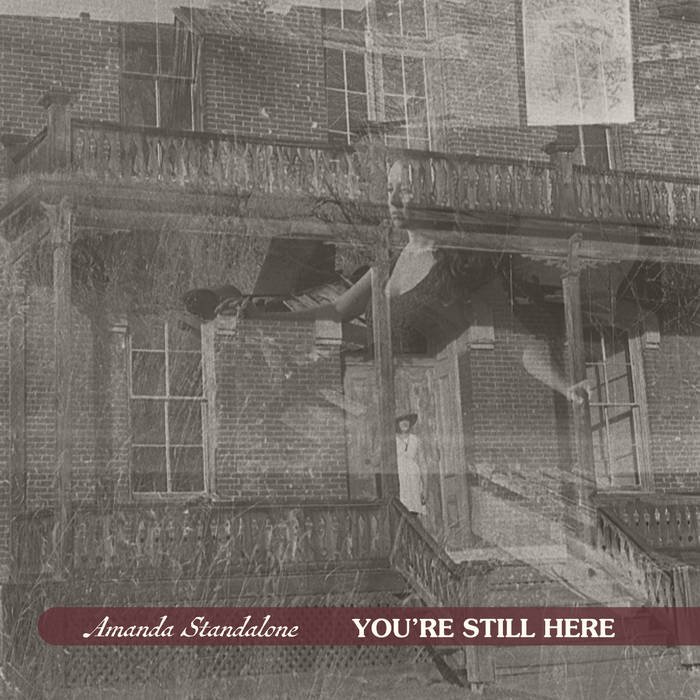Music Review: Amanda Standalone, ‘You’re Still Here’
Just in time for Halloween, this ambitious new album combines oral storytelling with a wide range of folk music styles to create a campfire-worthy collection of supernatural narratives.
Amanda Standalone You’re Still Here album artwork.
It seems like everywhere I look recently, there’s an element of prose storytelling finding its way into music. I always appreciate the stage patter between songs at a show—it’s one of the many special charms of seeing music performed live—but I don’t really think of it as storytelling.
But recently, I’ve encountered several compelling examples of prose as a kind of connective tissue weaving songs together. Minneapolis folk artist Luke Callen has created an entire set (called “The Ballad of Catfish Lou”) that uses storytelling between songs to tie them into a narrative. Duluth’s Charlie Parr has published a not-quite-fiction book called The Last of the Better Days Ahead that’s meant as a companion to his recent album of the same name. Minnesota transplant D.C. Leonhardt rhapsodized at a recent show about an Arlo Guthrie live album, where the talk between songs was especially inspiring to him.
And Minneapolis singer-songwriter Amanda Standalone just released a new album where stories and songs intertwine in a way I’ve never quite encountered before.
It opens with a tangle of voices, their words not quite intelligible. Then a piano starts up, a bluesy refrain, and a woman says “I think one of the first things I remember is seeing shadows.” One after another, unidentified people tell snippets of supernatural encounters over the tinkling keyboard. The voices die down, the piano fades out, and that’s “Skeleton Dance,” the first track on You’re Still Here.
Amanda Standalone. Photo courtesy of the artist.
Nearly every track that follows opens with a different anecdote, intriguingly sampled so the specifics are unknown but the core of the story comes through. Instruments come in and Amanda starts singing. Sometimes she seems to take on a role from the story being told—either the person relating the story or the supernatural entity it’s about—where other times she’s the narrator, breathing visual and emotional life into the story fragment.
The instrumentation changes with each song, as does the style of music and the type of paranormal situation. “You’re Still Here” is a classic ghost story, told over simple fingerstyle acoustic guitar and cello, about feeling the presence of dead family members, framed as a one-sided conversation with a departed loved one: “I can feel you in these walls / your voice is in my ears / I see your face in these mirrors / let me know you’re still here.”
On “Grandpa’s Grave,” fiddle and banjo join acoustic guitar and bass for an old-time country song, an ode to grandparents whose love lasts beyond their lives. Several people tell stories about a miner’s premonition before a disaster on “Milford Mine,” a riff on the classic “hi diddle i diddle i fie” folk song style, a capella except minimal percussion from what sounds like clogging.
“I Ain’t Right,” an ominous folk song set to acoustic guitar, starts with a former pastor relating demonic possession stories and is told from the perspective of the possessed; “I’m in trouble deep” is the refrain. Even more chilling, “Ivy” could be from the point of view of a murdered woman haunting her murderer’s next victim to try and save her: “Heed my warning / your end draws near,” she repeats, accompanied by multiple string band instruments and a distant-sounding chorus of voices. The song ends with a spin on another classic song: “O death, won’t you spare her over ‘til another year.”
Strings and accordion play a dark waltz on the enigmatic fairytale narrative “Stepmother’s Song.” On the minimalist doo-wop track “Infinite,” electric guitar ringing with reverb matches Amanda’s wail and the desperate lyrics about being tortured by unending love (and perhaps visits from the spirit of a dead lover). The Irish ballad style used in “The Widow’s Lament” is accompanied only by what sounds like a cello, long dark drawn-out chords that give it almost an organ or accordion effect.
Amanda Standalone (with Mikkel Beckmen). Photo by Carol Roth, 2021.
The album ends on a playful note with the final track, “Ouija Board Song,” a jazzy tune (“Hello operator, can you put me through to the other side?”) possibly from the POV of the board itself or the spirit inhabiting it. Our dealings with the spirit world end with the repeated refrain “It’s ABC, 123, yes, no, goodbye” and the unmistakable voice, unexpectedly, of none other than Charlie Parr relating his daughter’s frightening encounter with a ouija board.
You’re Still Here is an ambitiously diverse album stylistically, but Amanda nails the vocal delivery and instrumental arrangement of each track. The pairings of styles with supernatural themes and the accompaniment of different voices telling their stories gives it the feel of an anthology, a lively compendium of human experiences, superstitions, folk music traditions, instruments and vocal techniques. It feels fresh and experimental yet grounded in history and culture. Most of all, it’s just a lot of fun to listen to.
Carol Roth is a full-time marketing copywriter and the primary music journalist and social media publicist for Adventures in Americana. In addition to studying the guitar and songwriting, Carol’s additional creative side hustle is writing self-proclaimed “trashy” novels under the pseudonym T.A. Berkeley!



